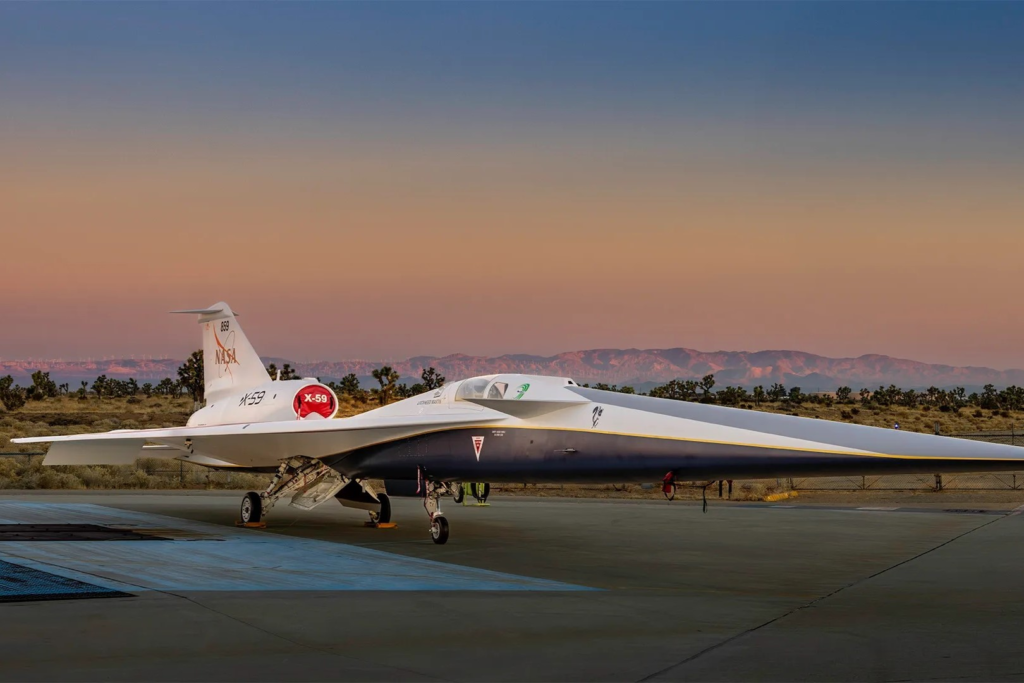NASA says the futuristic-looking X-59 quiet supersonic research aircraft is closing in on its first flight, with engineers conducting final checks of safety systems as the program moves from ground testing toward the all-important flight-test phase.
The milestone will mark the start of a lengthy flight-test regimen for the agency’s Quesst mission, which aims to prove that supersonic aircraft can fly over land without producing the window-rattling sonic booms that have long restricted faster-than-sound travel.
The maiden flight could come within weeks, following low-speed taxi runs completed in July at Edwards Air Force Base in California. On July 17, NASA released video and images showing the aircraft rolling under its own power for the first time. Medium- and high-speed taxi tests are now planned as the last step before first flight, with crews focusing on tests of braking, steering, stability, and the jet’s unique external vision system, which replaces a forward cockpit window.
NASA says the X-59’s first sortie will be a short hop, flying to about 12,000 feet at speeds of roughly 240 miles per hour before returning to base. The initial focus will be system integration and safety checks, verifying engine performance, stabilization, instrumentation, autopilot, and control systems. Later tests will gradually expand the flight envelope, taking the jet higher and faster until it breaks the sound barrier and reaches its design cruise speed of about Mach 1.4.
At supersonic speeds, the X-59 is designed to replace the ear-splitting sonic “boom” heard on the ground with a muted “thump,” NASA said. If successful, the demonstrator could help regulators in the U.S. and abroad set noise standards for commercial flight, opening the door for a new generation of passenger jets to fly over land at Mach speeds.
Safety has been a central theme as the program nears first flight, NASA stressed. The aircraft carries a Flight Test Instrumentation System that logs 60 data streams and more than 20,000 onboard parameters. Engineers say it has already collected thousands of files during ground trials, giving them a detailed baseline for comparison once the plane is airborne.
The single-seat X-59 also uses digital fly-by-wire controls, a NASA innovation from the 1970s that has become standard in many modern jets. In the demonstrator, multiple redundant computers ensure the aircraft cannot exceed its flight envelope, while backup electrical and hydraulic systems provide further layers of protection. In case of engine failure, an emergency hydrazine-powered restart system can quickly restore power.
At its planned cruise altitude of 55,000 feet, the pilot will rely on a dedicated life-support system and wear a pressure suit. The aircraft is also equipped with an ejection seat from the T-38 jet trainer as a last-resort safety option, NASA said.
Nils Larson, NASA’s lead test pilot, is scheduled to take the controls for the maiden flight. “It’s not your airplane – it’s the crew chief’s airplane – and they’re trusting you with it. You’re just borrowing it for an hour or two,” he said, underscoring the trust between flight crews and ground teams.
The X-59 is central to NASA’s Quesst mission, a multi-year effort to gather noise data that will be shared with regulators worldwide. Alongside private ventures such as Boom Supersonic and Spike Aerospace, and with growing interest from lawmakers, the project reflects renewed enthusiasm in the realm of commercial supersonic travel not experienced since the days Concorde plied the skies at speeds above Mach 2.
If the X-59 delivers on its promise, it could mark the beginning of a new era: scheduled commercial flights traveling faster than the speed sound, not just across oceans, but over land as well.


